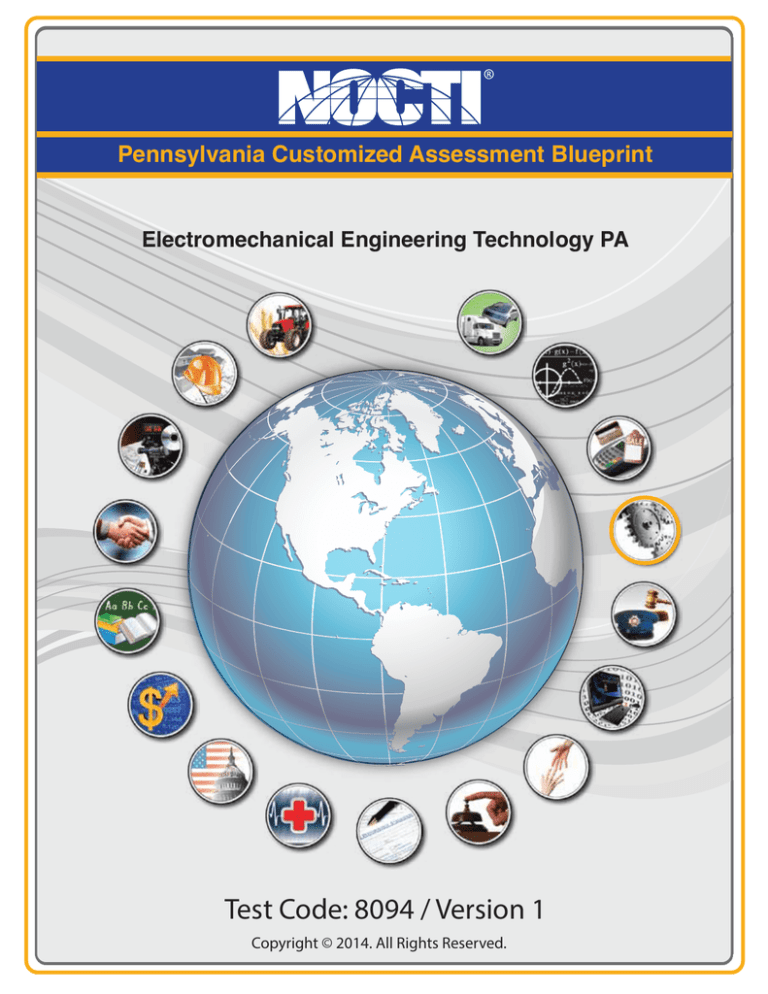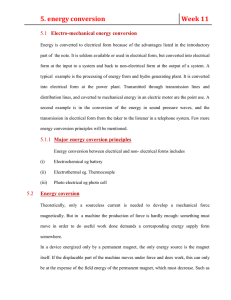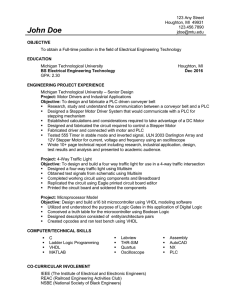
Pennsylvania Customized Assessment Blueprint
Electromechanical Engineering Technology PA
Test Code: 8094 / Version 1
Copyright © 2014. All Rights Reserved.
Electromechanical Engineering Technology PA
General Assessment Information
Blueprint Contents
General Assessment Information
Sample Written Items
Written Assessment Information
Performance Assessment Information
Specific Competencies Covered in the Test Sample Performance Job
Test Type: The Electromechanical Engineering Technology assessment was developed
based on a Pennsylvania statewide competency task list and contains a multiple-choice
and performance component. This assessment is meant to measure technical skills at
the occupational level and includes items which gauge factual and theoretical
knowledge.
Revision Team: The assessment content is based on input from Pennsylvania educators
who teach in approved career and technical education programs.
CIP
Code
15.0403- Electromechanical
Technology/Electromechanical
Engineering Technology
Career Cluster 10- Manufacturing
In the lower division
baccalaureate/associate degree
category, 3 semester hours in
Electromechanical Engineering
Technology (9/14). NOTE: An
additional 1-2 credits may be
awarded based on successful
completion of the Performance
Component when given in
conjunction with the written
proficiency examination.
Pennsylvania Customized Assessment
Page 2 of 13
Electromechanical Engineering Technology PA
Written Assessment
NOCTI written assessments consist of questions to measure an individual’s factual
theoretical knowledge.
Administration Time: 3 hours
Number of Questions: 200
Number of Sessions: This assessment may be administered in one, two, or three sessions.
Areas Covered
11%
15%
21%
4%
13%
6%
10%
7%
7%
6%
Pennsylvania Customized Assessment
Page 3 of 13
Electromechanical Engineering Technology PA
Specific Standards and Competencies Included in this Assessment
Technical Documentation and Safety
• Identify components of technical reports
• Demonstrate knowledge of the common components of technical documents
• Demonstrate knowledge of accident prevention
• Identify safe work habits
• Demonstrate safe and proper use of hand tools
• Demonstrate safe and proper use of portable power tools
• Demonstrate safe and proper use of the drill press
• Describe the dangers of unruly behavior
• Identify electric shock hazards
• Identify fire dangers of electronic circuits
• Use appropriate fire extinguishers for different classes of fires
• Describe the importance of SDS information
• Describe and understand Arc Flash Protection and National Fire Protection Act 70E
• Describe and demonstrate the Lock-Out/Tag-Out procedure
Industrial Motor Controls
• Identify and interpret electrical symbols, notes, details, and components on
schematics
• Identify symbols and terms used in electromechanical motor control circuits
• Identify relays, contactors, and motor starters
• Read schematic wiring diagrams of motors and their controls
• Wire a simple two- and three-wire motor control circuit
• Wire a reversing starter
• Wire multiple push button/jogging control circuits
• Wire sequential control circuits
• Wire and test electrical control circuits
• Perform preventive maintenance and troubleshooting on motor controls
• Identify and describe classes of wire insulation
• Describe conductor ampacity
• Describe how to select “wire size” and “wire type” for a specific wiring application
• Demonstrate procedures for the correct labeling of wires
• Interpret electrical diagrams
• Troubleshoot and replace relays
(Continued on the following page)
Pennsylvania Customized Assessment
Page 4 of 13
Electromechanical Engineering Technology PA
Specific Standards and Competencies (continued)
Fundamentals of Electricity
• Describe the origins and applications of magnetism
• Describe the idea of a magnetic force
• Describe the atomic structure of materials
• Describe the direction of electron flow in circuits
• List the effect of electric current flow
• Construct simple circuits
• Define electricity
• Describe the electrical force, which causes current flow
• Describe the characteristics and purposes of good conductors of electricity
• Demonstrate the use of prefixes in the metric system of measurement
• Demonstrate knowledge of “power”
• State Ohm’s Law
• State Watt’s Law
• Use an analog and a digital multimeter to measure voltage, amperage, and
resistance
• Use and care for analog and digital meters
• Perform a continuity test
• Define resistance
• Describe how length and thickness of wire affect resistance
• Measure resistance using a meter
• Calculate resistance
• Describe how the flow of an electric current generates heat
• Calculate total resistance values
• Identify values for color-coded resistors
• Describe the operation of a capacitor
• Build and test a series circuit
• Build and test a parallel circuit
• Build and test a series/parallel circuit
• Troubleshoot series and parallel circuits
(Continued on the following page)
• Calculate voltage, current, and resistance
• Measure voltage, current, and resistance
Pennsylvania Customized Assessment
Page 5 of 13
Electromechanical Engineering Technology PA
Specific Standards and Competencies (continued)
Use the National Electric Code® (NEC) Reference Book
• Describe regulations for wiring
• Explain the NEC® code for sizes and types of wire conductors, raceways, and boxes
• State the NEC rules for grounding and bonding
• Describe the NEC rules for over-current protection devices
• Locate the NEC code for motor circuit wiring
• Use the NEC reference book to locate regulations for industrial electrical installations
Motors and Transformers
• Demonstrate knowledge of basic direct current circuits
• Explain the theory of operation of a direct current motor
• Operate and test a direct current motor
• Demonstrate knowledge of technical terms and units used in a basic direct current
circuit
• Explain the theory of operation of alternative current motors
• Describe operating characteristics of capacitor-start motors
• Connect and operate split-phase and capacitor-start motors
• Reverse the rotation of a split-phase motor
• Describe the force between two magnetic fields
• Connect and operate a three-phase, squirrel cage motor
• Demonstrate how to reverse the rotation of a three-phase motor
• Connect and operate a transformer
• Calculate the voltage-and-turns ratio
• Connect a “step-up” and a “step-down” transformer in a circuit
• Identify transformer windings and related output voltages
• Measure single-phase transformer voltage and currents
• Measure series/parallel transformer voltages and currents
• Demonstrate knowledge of three-phase transformers
• Wire and analyze three-phase transformers
(Continued on the following page)
Pennsylvania Customized Assessment
Page 6 of 13
Electromechanical Engineering Technology PA
Specific Standards and Competencies (continued)
Electronic Fundamentals
• Describe proper care for soldering equipment
• Demonstrate proper soldering techniques for splicing conductors
• Demonstrate proper soldering techniques for terminals
• Identify and explain electronic symbols shown on diagrams and schematics
• Describe and explain the function of diodes
• Explain the function of Zener diodes
• Explain the function of power supplies
• Explain the function of half-wave, full-wave, and three-phase rectifiers
• Explain the function of single-phase and three-phase inverters
Programmable Logic Controllers (PLCs)
• Demonstrate knowledge of number systems
• Convert binary and decimal number systems
• Demonstrate knowledge of switch logic
• Identify characteristics of AND, OR, NAND, NOR, and NOT logic
• Demonstrate knowledge of AND, OR, NAND, NOR, and NOT logic
• Explain where PLC networks may be used in the manufacturing process
• Identify the parts and operating principles of programmable logic controllers
• Demonstrate knowledge of number systems and codes for PLCs
• Create a relay logic diagram
• Describe the PLC logic gate functions in PLCs
• Explain PLC logic and math functions
• Explain PLC timer and counter functions
• Demonstrate procedures for editing PLC programs
• Troubleshoot a PLC system
(Continued on the following page)
Pennsylvania Customized Assessment
Page 7 of 13
Electromechanical Engineering Technology PA
Specific Standards and Competencies (continued)
Mechanical Power Transmission Systems
• Identify vocabulary words and terms associated with the fundamental principles of
the transmission of mechanical power
• Construct simple machines and use them to illustrate mechanical principles
• Identify basic principles of lubrication of bearings
• Identify basic principles of installing and adjusting V-belts
• Demonstrate knowledge of the uses of brakes and clutches for mechanical power
transmission
• Set and adjust mechanical stops
• Install and maintain linkages
• Install and maintain gear trains
• Conduct routine preventive maintenance on hydraulic equipment in accordance
with manufacturer’s instructions
• Determine speed and torque rates of mechanical equipment components
(Continued on the following page)
Pennsylvania Customized Assessment
Page 8 of 13
Electromechanical Engineering Technology PA
Specific Standards and Competencies (continued)
Fluid Power Systems
• Identify electrical symbols and schematics for hydraulic systems
• Demonstrate knowledge of the fundamentals of hydraulics
• Examine characteristics of hydraulic pumps
• Measure oil flow and oil pressure
• Demonstrate the operation of manual and pilot directional control valves
• Describe and explain hydraulic actuators
• Describe the relationship between hydraulic pressure and flow
• Demonstrate knowledge of the fundamental principles of pneumatics
• Demonstrate knowledge of pneumatic actuators
• Construct, test, and troubleshoot a pneumatic circuit
Automated Manufacturing Systems
• Demonstrate knowledge of safety rules and regulations for working around
robots
• Use vocabulary words and terms specific to robotics
• Identify major systems of a robot
• Identify a robot’s “work envelope’’ in a manufacturing cell
• Explain how robots are used in American manufacturing industries
• Describe the operation of a robot’s drive system
• Describe the mobility of an industrial robot
• Demonstrate the procedure for programming a robot
• Describe industrial applications for robotics
• Demonstrate knowledge of the fundamental operating principles used in flexible
manufacturing systems
• Assemble and test a fluid power work-cell using PLC sensors
Pennsylvania Customized Assessment
Page 9 of 13
Electromechanical Engineering Technology PA
Sample Questions
NFPA 70E® is a regulation that provides guidelines and details for
A. fire extinguisher use
B. proper material selection
C. electrical safety
D. scaffold use
The NEC states that a non-metallic sheathed cable be secured by staples or straps
within _____ from every cabinet, box, or fitting.
A. 5 inches
B. 6 inches
C. 10 inches
D. 12 inches
Every digital multimeter can measure which three basic elements?
A. capacitance, voltage, and resistance
B. current, voltage, and resistance
C. current, voltage, and capacitance
D. capacitance, current, and resistance
The rate at which energy is consumed by a circuit is called
A. joules
B. power
C. current
D. voltage
Two XIC instructions placed in series with an output instruction is defined as _____
logic.
A. AND
B. OR
C. NOT
D. NOR
(Continued on the following page)
Pennsylvania Customized Assessment
Page 10 of 13
Electromechanical Engineering Technology PA
Sample Questions (continued)
Who is responsible for enforcing the NEC?
A. journeyman or woman
B. contractor
C. electrical engineer
D. local authority having jurisdiction
Motors are normally protected from overload by a/an _____ device.
A. relay
B. eutectic
C. limit switch
D. thermal
To properly store a solder pencil or start any soldering procedure, the technician
should
A. tin the tip
B. sweat the tip
C. wipe the tip
D. unplug the pencil
Parallel shaft alignment is where
A. the centerlines of the two shafts are parallel
B. there is an angle between the two shafts' centerlines
C. one shaft is larger than the other shaft
D. one shaft turns the same direction as the other
Which statement is true about hydraulic systems?
A. The amount of air in the system can vary quite a bit without affecting the system.
B. Hydraulic fluid is not usually changed entirely, but rather more fluid is added
periodically to replenish the system.
C. Any crankcase oil can be used as hydraulic fluid, even if not specifically
recommended.
D. The fluid must be kept as clean as possible for the system to operate properly and
avid damage.
Pennsylvania Customized Assessment
Page 11 of 13
Electromechanical Engineering Technology PA
Performance Assessment
NOCTI performance assessments allow individuals to demonstrate their acquired skills by
completing actual jobs using the tools, materials, machines, and equipment related to the
technical area.
Administration Time: 3 hours
Number of Jobs: 5
16%
29%24%
Areas Covered:
16% Cut and Bend Conduit
Participant will use safety considerations, demonstrate
EMT cutting resulting in ends of conduit being square
and deburred with proper bending.
15%
12%
76%
28%
15% Wiring a Motor Control Circuit, Motor, and Indicator Light
Participant will select conductors, demonstrate safe operation of a motor, and clean-up of
the work area.
28% DC Circuit Construction and Analysis
Participant will select components, demonstrate construction of a circuit, use calculations
and measurements with consideration for safety.
12% Fluid Power
Participant will use safety considerations, supply pressure safety, and circuit construction.
29% PLC Logic
Participant will input instruction type, E-stop, seal-in circuit, complete documentation, and
final program logic.
Pennsylvania Customized Assessment
Page 12 of 13
Electromechanical Engineering Technology PA
Sample Job
Wiring a Motor Control Circuit, Motor, and Indicator Light
Maximum Time: 45 minutes
Participant Activity: The participant will study the diagram provided, select the tools,
equipment, and supplies for proper completion of this job, wire the circuit according to
the diagram provided, select and label the conductors, check for continuity of control
circuit and motor wiring, notify the evaluator so installation can be approved, operate
and troubleshoot as necessary, return tools, equipment, and supplies to their proper
place, and notify the evaluator when ready for a final evaluation.
Pennsylvania Customized Assessment
Page 13 of 13




